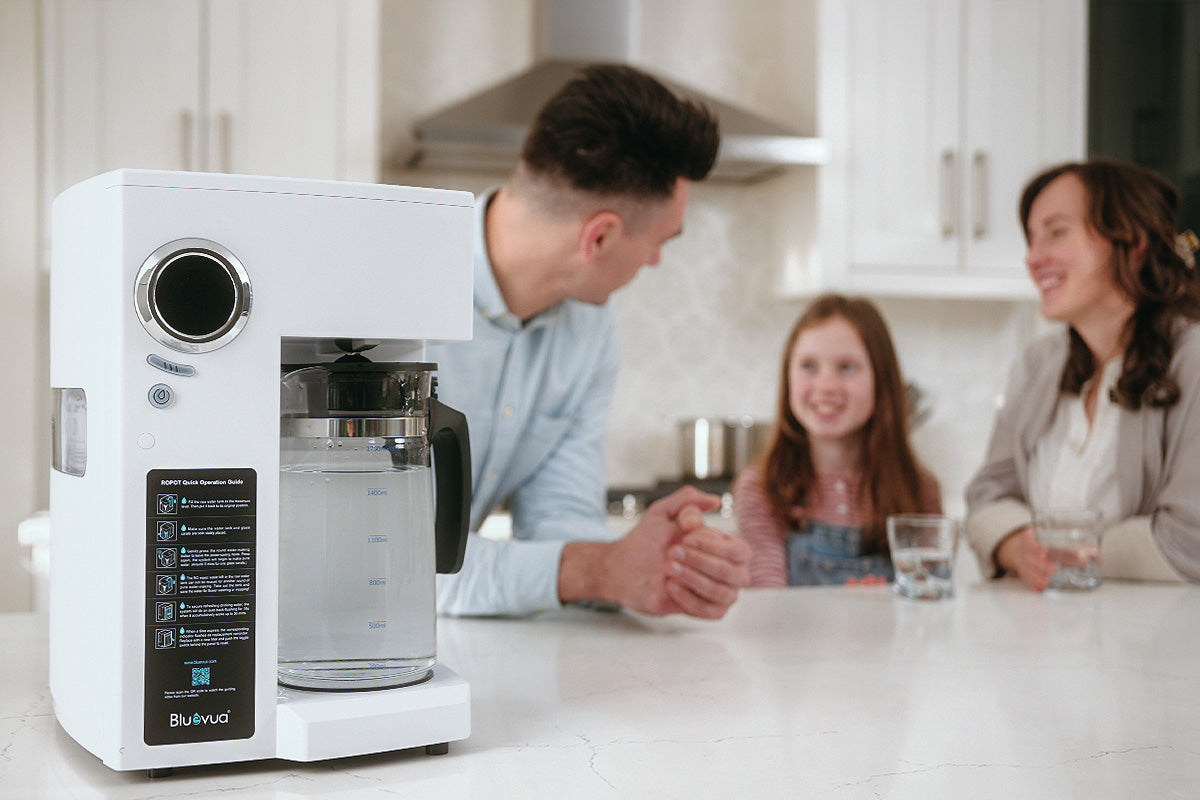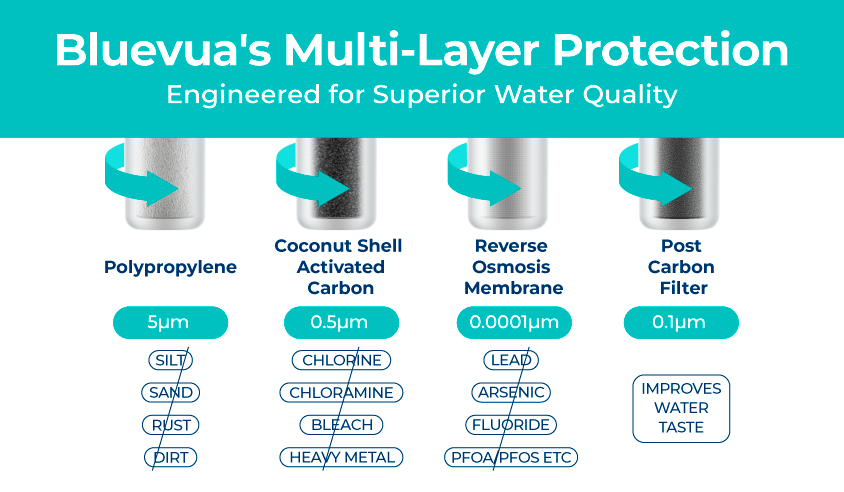Do you know how those reverse osmosis (RO) filters give you such clean drinking water? RO systems are becoming a favorite choice for many because of the pure water they deliver right to our glasses. But there's a hitch that often makes people think twice: these systems also create what's called 'wastewater '(RO reject water). In this easy-to-follow guide, we'll tell you why RO systems produce this extra water and how it doesn't have to go to waste.
1. How RO Filters Work
What exactly is reverse osmosis, and why does it stand out from other water filtration methods? Unlike your standard filters, which might use physical or chemical means to clean water, RO uses a fine membrane that catches almost everything you don't want in your drinking water, like salts, bacteria, heavy metal ions, and those tiny particles.

A Cut Above Other Filters
Simple Polypropylene(PP) Filters
-
Material and Structure:
Made from melt-blown polypropylene fibers, these filters have a layered structure that creates a gradient for particle removal. The outer layers catch larger particles, while the inner layers are tighter and remove smaller sediments. -
Particle Size Filtration:
These filters generally target particles in the range of 5 to 10 microns. To put that into perspective, the human eye can only see particles larger than about 40 microns. Simple PP filters efficiently remove visible particles such as dirt, rust, and sediment. - Limitations: They're not equipped to handle contaminants smaller than their filtering capacity. Chemicals, heavy metals, bacteria, and viruses will pass right through a PP filter.
Activated Carbon Filters
- Composition: Activated carbon is a form of carbon processed to have small, low-volume pores that increase the surface area available for adsorption or chemical reactions. This makes it incredibly effective at trapping certain chemicals.
- Functionality: These filters work through a process called adsorption, where contaminants chemically bind to the surface of the carbon. They're particularly good at removing chlorine, volatile organic compounds (VOCs), and certain pesticides, all of which can affect the taste and smell of your water.
- Taste and Odor Improvement: A significant benefit of activated carbon filtering is the noticeable improvement in water's palatability. By reducing chlorine and other compounds that give water a bad taste or odor, this stage greatly enhances the sensory quality of drinking water.
- Limitations: Activated carbon filters don't capture minerals like calcium and magnesium (which comprise hardness in water), fluoride, or pathogens like bacteria and viruses. Additionally, once the active sites on the carbon are filled, the filter can begin to release captured contaminants back into the water if not replaced timely.

RO systems, on the other hand, push water through their specialized membranes under pressure, filtering out contaminants down to 0.0001 microns – that's about one ten-millionth of a millimeter! This means they can remove a much broader range of impurities than PP or activated carbon filters alone, making for some of the cleanest water you can get from a tap.
The Necessity of Wastewater
But here comes the rub – it's not about what passes through but also what doesn't. In an RO system, as water passes through, collected is the filtered water, also known as the permeate. The leftovers full of the trapped contaminants – concentrate – have to go somewhere. That is what we call 'wastewater' or RO reject water. This might sound really wasteful, but it's a critical step in the process. If these impurities are not flushed out, they will block the works or even slip back into the clean water supply. Hence, this waste water is not a by-product but an integral part of the process of maintaining both high water quality and the efficiency of the RO system.
2. Under-Sink vs. Countertop RO Systems
Consider the different RO systems you can adopt for your home: under-sink and countertop, mainly taking into account the quantity of wastewater they produce. While all of them aim to give pristine water, they deal with waste in radically different ways.

Two Ratios
The most common under-sink RO units have a wastewater ratio of around 1:4. That means for every gallon of filtered water produced, four gallons of wastewater are generated, carrying away contaminants. Countertop RO systems tend to be more water-efficient, boasting a ratio closer to 3:1, so for every three gallons of filtered water, only one gallon of wastewater is produced.
Counterintuitive Countertop Efficiency
Countertop RO systems are engineered to optimize water use. The secret lies in their wastewater recycling mechanism. The RO membrane at the heart of these systems has a threshold for how much water it can handle at once. Exceeding the RO membrane's filtration limit and continuously applying pressure may stress its material structure, causing degradation or failure over time.
To combat this, countertop units cleverly mix untreated water with water that has already passed through an initial filtration stage. This dilution reduces the concentration of contaminants before reaching the final RO membrane, decreasing the stress on the membrane and subsequently lowering the volume of wastewater generated. Not only does this protect and extend the membrane's lifespan, but it also conserves water.

In contrast, traditional under-sink systems lack this mechanism. They typically expel wastewater directly, without the chance for reuse or re-filtration, leading to higher overall wastewater production. Although this process remains out of sight for most users, it is less efficient and less sustainable.
3. How to Repurpose RO Wastewater
Instead of letting it go down the drain, we can repurpose this so-called 'waste' in smart, eco-friendly ways.
Not a Drop to Waste
Firstly, debunk a common misconception: RO wastewater isn't dirty or harmful. Yes, it contains more minerals and impurities than the purified water, but remember, it has already gone through pre-filtration. This means it's cleaner than most natural water sources and can be safely used for various non-drinking purposes.
Household Uses for RO Wastewater
Here are some practical ways you can use RO wastewater at home:
- Gardening: Plants generally love the extra minerals found in RO wastewater. Use it to water your garden, lawn, or houseplants.
- Cleaning: The water is perfect for mopping floors, washing cars, or cleaning patios. Its minimal impurity content won't leave residue on surfaces.
- Laundry: If you have a way to channel it to your washing machine, RO wastewater can be used for pre-washing clothes, especially for some heavy-duty cycles.
- Flushing Toilets: Collecting wastewater to flush toilets is an excellent way to conserve water. It's a setup investment that pays off by reducing your freshwater consumption significantly.

The Bigger Picture
While each individual reusing RO reject water numbers may seem small, on a larger scale of the applications, the numbers represent an accumulated huge volume. Communities can install systems to collect massive amounts of RO wastewater for use in green spaces or industrially. Additionally, manufacturers have applied themselves to the task of developing more efficient RO systems that initially waste less raw water.
4. Transforming RO Wastewater from Waste to Resource
Reverse osmosis avails the opportunity for unrivaled purity of water while creating a challenge in terms of having a wastewater by-product. Once more, where challenges appear, there also lies the channel for innovation and sustainability. By simply reimagining how we view and use RO wastewater, we can reduce our environmental impact and, at best, make serious strides toward more sustainable living. From tending our gardens to cleaning our homes, working in the smallest way, including within larger community efforts, every action forms a future where each drop of water counts. We look forward to advancing technologies for far more efficient systems that promise purity-no compromises accepted.





ทิ้งข้อความไว้
ความคิดเห็นทั้งหมดจะได้รับการตรวจสอบก่อนที่จะเผยแพร่
เว็บไซต์นี้ได้รับการคุ้มครองโดย hCaptcha และมีการนำนโยบายความเป็นส่วนตัวของ hCaptcha และข้อกำหนดในการใช้บริการมาใช้